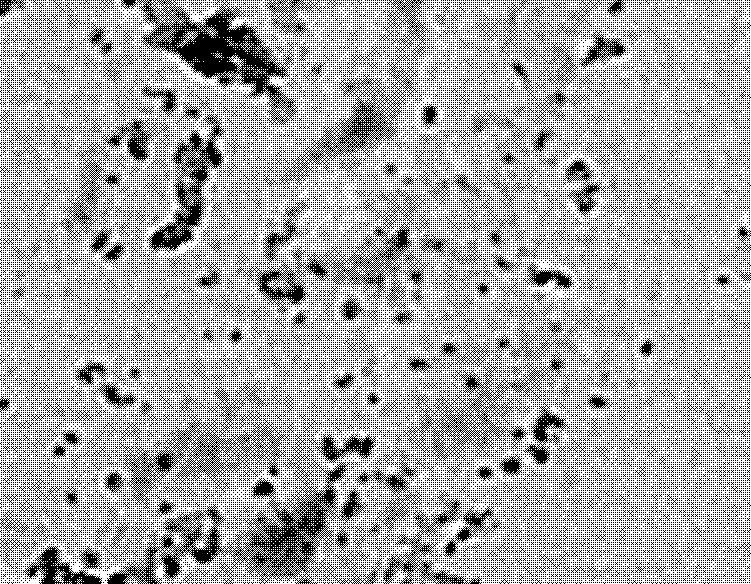Magnetic enzyme nanogel biocatalytic particle and preparation method thereof
A magnetic nanoparticle and nanogel technology, applied in the direction of being fixed on or in an inorganic carrier, immobilized on or in an organic carrier, etc., can solve the problems of inability to recycle, poor thermal stability of natural enzymes, etc. No mass transfer and diffusion resistance, reduce the loss of enzyme activity, and have the effect of strong thermal stability
- Summary
- Abstract
- Description
- Claims
- Application Information
AI Technical Summary
Problems solved by technology
Method used
Image
Examples
Embodiment 1
[0045] Example 1: Preparation of magnetic lipase nanogel biocatalytic particles
[0046] 1) Preparation of ferric oxide nanoparticles with superparamagnetism
[0047] Raw materials: 2 parts by mole of ferric chloride, 1 part by mole of ferrous chloride, 7 parts by weight of ammonia water (mass concentration 30%), 10 parts in total.
[0048] Dissolve ferric chloride and ferrous chloride in double-distilled water at a molar ratio of 2:1, add dilute hydrochloric acid dropwise to adjust the pH of the solution to less than 2, and pass nitrogen gas for 30 minutes to remove oxygen. Cool the above-mentioned ferric chloride / ferrous chloride solution to 4-8°C, and quickly add 7 parts of cooled ammonia water under the condition of rapid stirring (rotating speed greater than 1,000 rpm), to form a black colloidal solution. The temperature of the reaction system was increased to 70° C., and kept for 30 minutes, magnetically stirred, and nitrogen gas was kept flowing at the same time, to ob...
Embodiment 2
[0057] Example 2: Preparation of magnetic trypsin nanogel biocatalytic particles
[0058] Change the target enzyme in Example 1 into 20 parts of trypsin, and the magnetic particles into: 80 parts of ferric oxide nanoparticles II modified with carboxyl and double bonds prepared in Example 1, and 400 parts of vinyl-containing monomers Parts of acrylamide, 4 parts of methylene bisacrylamide as crosslinking agent, 8 parts of ammonium persulfate and 12 parts of N, N, N', N'-tetramethylethylenediamine as mixture of initiator. All the other steps are the same as in Example 1.
[0059] Finally, the trypsin magnetic enzyme nanogel was dispersed in the CaCl-containing 2 10mM, pH 8 in 50mM Tris-Cl activation buffer. Using Na-benzoyl-DL-arginine-p-nitroamide hydrochloride as a substrate to measure the biocatalytic activity of trypsin magnetic enzyme nanogel biocatalytic particles, the total yield was 95%, and the polymerization yield was 89%, and the product particle size is 200nm.
Embodiment 3
[0060] Example 3: Preparation of magnetic cytochrome acrylic nanogel biocatalytic particles
[0061] Change the target protein in Example 1 into 10 parts of cytochrome c, and the magnetic particles into: 40 parts of ferric oxide nanoparticles II modified with carboxyl and double bonds prepared in Example 1, and change the vinyl monomer into 300 parts Part of sodium acrylate and crosslinking agent were changed to 0.5 part of N, N'-methylenebisacrylamide, and the rest of the formula and steps were the same as in Example 1. At this point, the product obtained is measured with 2'-azino-bis(3-ethylbenzothiazole-6-sulfonic acid) and hydrogen peroxide as the total yield of the biocatalytic activity of the nanometer macromolecular biocatalytic particles. 82%, the polymerization yield is 70%, and the product particle size is 250nm.
PUM
| Property | Measurement | Unit |
|---|---|---|
| particle diameter | aaaaa | aaaaa |
| thickness | aaaaa | aaaaa |
| particle diameter | aaaaa | aaaaa |
Abstract
Description
Claims
Application Information
 Login to View More
Login to View More - R&D Engineer
- R&D Manager
- IP Professional
- Industry Leading Data Capabilities
- Powerful AI technology
- Patent DNA Extraction
Browse by: Latest US Patents, China's latest patents, Technical Efficacy Thesaurus, Application Domain, Technology Topic, Popular Technical Reports.
© 2024 PatSnap. All rights reserved.Legal|Privacy policy|Modern Slavery Act Transparency Statement|Sitemap|About US| Contact US: help@patsnap.com










